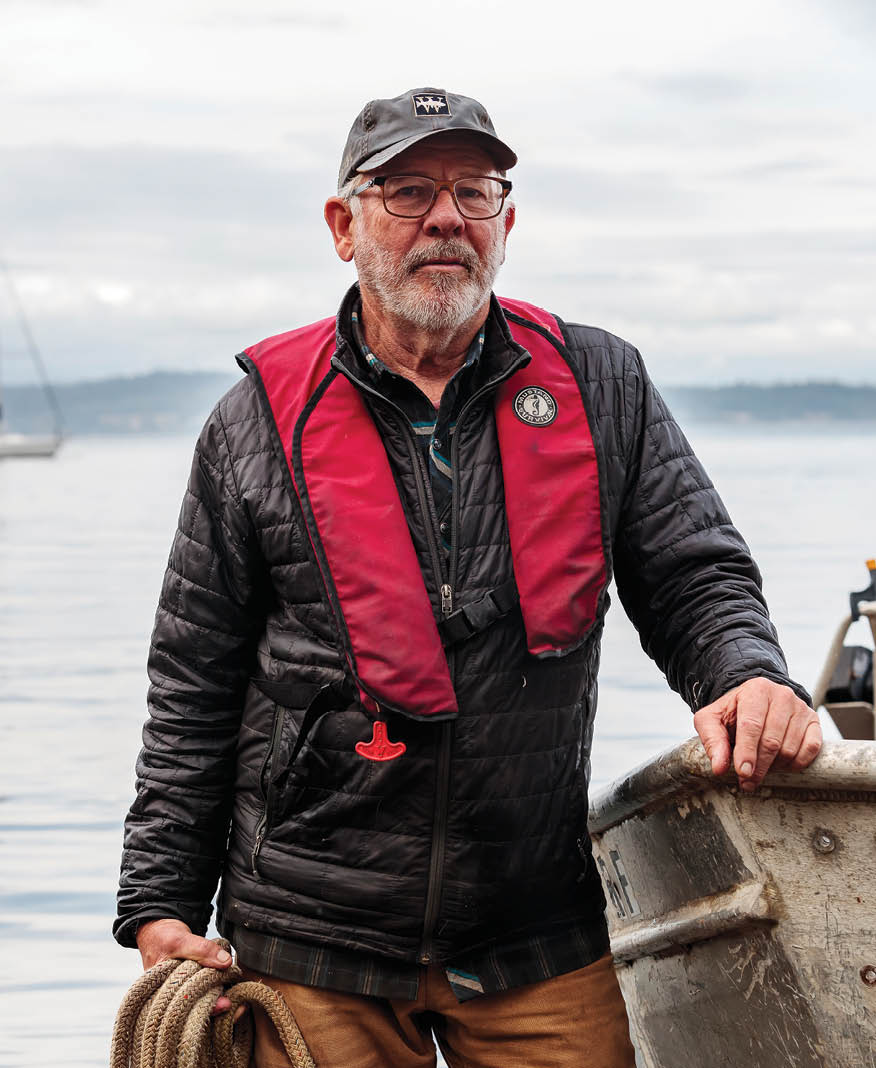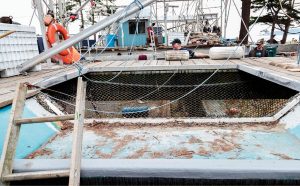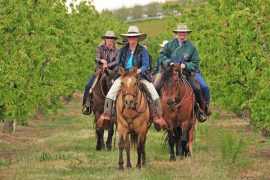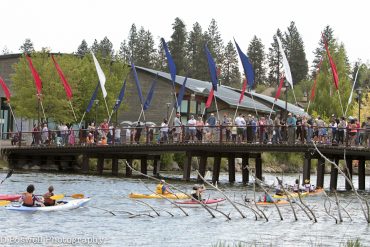The quest to protect Salish Sea products, and to share their quality with the world
written by Naomi Tomky | photography by Brandon Sawaya
Champagne, Colombian coffee, Stilton cheese … and Salish Sea sustainable seafood? The idea of an AOC, or protected designation of origin, is an old one in Europe, where regions fiercely protect their local traditions from imposters. It has slowly made its way to the rest of the world. Now Riley Starks wants to create one that marks halibut, salmon, Dungeness crab and other delicacies of the Pacific Northwest as uniquely of this region, demanding the high standard of quality as other protected products, such as Prosciutto di Parma or Roquefort cheese.
Starks’ name may ring a bell for local food lovers—in 2010, he brought chef Blaine Wetzel to his tiny Lummi Island bed and breakfast, changing the course of Pacific Northwest gastronomy and catapulting The Willows Inn onto worldwide best restaurant lists. But Starks has since sold the Inn and is now committed to the same ingredients that helped Wetzel earn stardom—specifically, the fish that swim near the island and the sustainable, traditional reefnet fishing culture of the Lummi Tribe that shares it. As executive director of the nonprofit Salish Center for Sustainable Fishing Methods, he works with tribal fishermen including president Lucas Kinley, and grocers and restaurateurs such as Larry Mellum of Pike Place Chowder, to educate the public about sustainable fishing methods and the health of the waterways of the Pacific Northwest (specifically, Puget Sound, the Strait of Juan de Fuca, and into British Columbia’s Strait of Georgia, cumulatively known as the Salish Sea) through the seafood on our plates.
In March, members of the Suquamish Tribe paddled their canoes up to the pier at Seattle’s Bell Harbor and began calling out the names of well-known chefs and fishmongers. One by one, chef Renee Erickson, as well as the new owners of the Pike Place Fish Market and the chef of Anthony’s Pier 66 each stepped up to receive a very special fish from the Suquamish: Salish Sea halibut. Once nearly destroyed, the local halibut fishery has made a comeback and now opens only to tribal fishermen. The season is short, but the fish is sweet and those in the know covet the annual chance to taste one of the region’s greatest treasures and the fruits of a sustainable seafood success story.
Until this push, the tiny, three-week-long halibut fishery in the region has been lumped together with the rest of the West Coast halibut fisheries. The 200,000 pounds of Salish Sea halibut making its way into restaurants and stores had no labeling that set it apart from the 20 million to 30 million pounds coming down from Alaska’s six-month season. The only thing that did set it apart, in fact, was its flavor—Salish Sea halibut don’t participate in the great migration of halibut that go from Oregon to Alaska, Starks said. “They live their adult life in the Salish Sea, where they’re eating spot prawns and Dungeness crab.” Sounds like a good life, right? The difference shows in their flavor and their texture. But without labels, “You could notice sometimes [the fish] is better than others,” Starks said. “But you won’t know why. There’s zero effort to designate the origin.”
That’s why this year, for the first time, each of the halibut handed over from the canoes came marked with a round blue tag with an orange diamond in the center, circled by the words “Salish Sea Certified.” Part of the problem before, Starks explained, is that there was no way to tell the halibut apart. “I have been around for a long time, I know the difference,” he said of the quality of Salish Sea halibut—and other seafood. But the tag gives others the opportunity to buy the best local fish. “There’s so many new people to Seattle who don’t know anything about the Salish Sea that it’s a great way for them to become a part of their environment and do something positive, basically just by recognizing and buying the product.
For Starks and the Salish Center, events like the canoe delivery create awareness around the labeling, and the labeling creates a differentiation that allows them to charge the kind of premium needed to sustainably fish the better product. He holds up Copper River salmon as the end goal: a label the late culinary marketer Jon Rowley managed to take from obscure fishery to a brand name synonymous with quality for savvy seafood eaters in the Pacific Northwest—and a booming business for fishermen who adhere to the quality standards it laid out. But Starks doesn’t stop with a trademarked brand. He envisions even bigger recognition—that coveted protected designation of origin bestowed upon only products deemed so specific to their home region that nothing similar can be grown, produced or caught anywhere else in the world. He hopes to see the Salish Sea’s sustainable seafood viewed in the same way as a Napa Valley wine—just naming the location connotes a certain quality.
When it comes to sustainable seafood, Starks said, consumers have mostly heard horror stories that are “dragging people down.” The idea behind the halibut celebration, August’s Paddling for the Pinks fishing derby in honor of pink salmon, and October’s Dungeness Crab events is to highlight products that are success stories, he said. The fisheries that have been saved from being nearly wiped out and are now thriving, like the Baker Lake sockeye salmon, revived from near extinction to a run of 50,000.
“People can see what’s harvested here, fall in love with it, and want to protect it,” Starks said. In the long run, the goal is to raise money to help protect it. The money raised through the labeling and the Salish Sea certification goes to five designated nonprofits dedicated to the health of the Salish Sea and its fisheries. The Northwest Straits Foundation, the Regional Fisheries Coalition and Long Live the Kings focus on habitat restoration, while the Oceans Initiative studies the orca habitats in the region and provides guidelines for regulations to boost their populations. The fifth nonprofit is the Salish Center itself, which Starks hopes will bring in enough money to be self-sustaining, with the fishermen paying for the medallion but earning that money back through the sale of the premium fish—an upcharge he estimates will look like about $1 per pound to the consumer on what might otherwise be a $20 per pound halibut.
Though the Salish Center is new—opened in 2017—Starks’ push for differentiation of Salish Sea methods and toward sustainability is not. He’s been a reefnet fisherman in Legoe Bay of Lummi Island for close to thirty years, and has been educating people about the sustainable fishing method since 2001, first through the Willows Inn, and later through the seafood company Lummi Island Wild. Lummi Island Wild, where Starks was the marketing manager, evolved recently from a co-op into separate fishing gears, and Starks ended up with one of the gears. He recognized nobody could afford to have him do the kind of sustainable fishing education he’d been doing for years, and so he decided to go out on his own as a nonprofit educational platform—the Salish Center.
“We’re still in the dream stage,” he admitted. “It’s awesome, but scary as hell.” The dream is to get the governor on board and try to get corporate buy-in from places such as Microsoft and Amazon, who are bringing people into the area. He knows his work is cut out for him. “It’s only going to work if it’s a recognizable logo with buy-in from the public.” But if they can get people to taste it, to try what they’re selling, he’s confident.
“I can’t think of a product that’s harvested here that is better,” he said. “If it doesn’t taste good, the story doesn’t matter.”
There’s so many new people to Seattle who don’t know anything about the Salish Sea that it’s a great way for them to become a part of their environment and do something positive, basically just by recognizing and buying the product.
Champagne, Colombian coffee, Stilton cheese … and Salish Sea sustainable seafood? The idea of an AOC, or protected designation of origin, is an old one in Europe, where regions fiercely protect their local traditions from imposters. It has slowly made its way to the rest of the world. Now Riley Starks wants to create one that marks halibut, salmon, Dungeness crab and other delicacies of the Pacific Northwest as uniquely of this region, demanding the high standard of quality as other protected products, such as Prosciutto di Parma or Roquefort cheese.
Starks’ name may ring a bell for local food lovers—in 2010, he brought chef Blaine Wetzel to his tiny Lummi Island bed and breakfast, changing the course of Pacific Northwest gastronomy and catapulting The Willows Inn onto worldwide best restaurant lists. But Starks has since sold the Inn and is now committed to the same ingredients that helped Wetzel earn stardom—specifically, the fish that swim near the island and the sustainable, traditional reefnet fishing culture of the Lummi Tribe that shares it. As executive director of the nonprofit Salish Center for Sustainable Fishing Methods, he works with tribal fishermen including president Lucas Kinley, and grocers and restaurateurs such as Larry Mellum of Pike Place Chowder, to educate the public about sustainable fishing methods and the health of the waterways of the Pacific Northwest (specifically, Puget Sound, the Strait of Juan de Fuca, and into British Columbia’s Strait of Georgia, cumulatively known as the Salish Sea) through the seafood on our plates.
In March, members of the Suquamish Tribe paddled their canoes up to the pier at Seattle’s Bell Harbor and began calling out the names of well-known chefs and fishmongers. One by one, chef Renee Erickson, as well as the new owners of the Pike Place Fish Market and the chef of Anthony’s Pier 66 each stepped up to receive a very special fish from the Suquamish: Salish Sea halibut. Once nearly destroyed, the local halibut fishery has made a comeback and now opens only to tribal fishermen. The season is short, but the fish is sweet and those in the know covet the annual chance to taste one of the region’s greatest treasures and the fruits of a sustainable seafood success story.
Until this push, the tiny, three-week-long halibut fishery in the region has been lumped together with the rest of the West Coast halibut fisheries. The 200,000 pounds of Salish Sea halibut making its way into restaurants and stores had no labeling that set it apart from the 20 million to 30 million pounds coming down from Alaska’s six-month season. The only thing that did set it apart, in fact, was its flavor—Salish Sea halibut don’t participate in the great migration of halibut that go from Oregon to Alaska, Starks said. “They live their adult life in the Salish Sea, where they’re eating spot prawns and Dungeness crab.” Sounds like a good life, right? The difference shows in their flavor and their texture. But without labels, “You could notice sometimes [the fish] is better than others,” Starks said. “But you won’t know why. There’s zero effort to designate the origin.”
That’s why this year, for the first time, each of the halibut handed over from the canoes came marked with a round blue tag with an orange diamond in the center, circled by the words “Salish Sea Certified.” Part of the problem before, Starks explained, is that there was no way to tell the halibut apart. “I have been around for a long time, I know the difference,” he said of the quality of Salish Sea halibut—and other seafood. But the tag gives others the opportunity to buy the best local fish. “There’s so many new people to Seattle who don’t know anything about the Salish Sea that it’s a great way for them to become a part of their environment and do something positive, basically just by recognizing and buying the product.”
For Starks and the Salish Center, events like the canoe delivery create awareness around the labeling, and the labeling creates a differentiation that allows them to charge the kind of premium needed to sustainably fish the better product. He holds up Copper River salmon as the end goal: a label the late culinary marketer Jon Rowley managed to take from obscure fishery to a brand name synonymous with quality for savvy seafood eaters in the Pacific Northwest—and a booming business for fishermen who adhere to the quality standards it laid out. But Starks doesn’t stop with a trademarked brand. He envisions even bigger recognition—that coveted protected designation of origin bestowed upon only products deemed so specific to their home region that nothing similar can be grown, produced or caught anywhere else in the world. He hopes to see the Salish Sea’s sustainable seafood viewed in the same way as a Napa Valley wine—just naming the location connotes a certain quality.
When it comes to sustainable seafood, Starks said, consumers have mostly heard horror stories that are “dragging people down.” The idea behind the halibut celebration, August’s Paddling for the Pinks fishing derby in honor of pink salmon, and October’s Dungeness Crab events is to highlight products that are success stories, he said. The fisheries that have been saved from being nearly wiped out and are now thriving, like the Baker Lake sockeye salmon, revived from near extinction to a run of 50,000.
“People can see what’s harvested here, fall in love with it, and want to protect it,” Starks said. In the long run, the goal is to raise money to help protect it. The money raised through the labeling and the Salish Sea certification goes to five designated nonprofits dedicated to the health of the Salish Sea and its fisheries. The Northwest Straits Foundation, the Regional Fisheries Coalition and Long Live the Kings focus on habitat restoration, while the Oceans Initiative studies the orca habitats in the region and provides guidelines for regulations to boost their populations. The fifth nonprofit is the Salish Center itself, which Starks hopes will bring in enough money to be self-sustaining, with the fishermen paying for the medallion but earning that money back through the sale of the premium fish—an upcharge he estimates will look like about $1 per pound to the consumer on what might otherwise be a $20 per pound halibut.
Though the Salish Center is new—opened in 2017—Starks’ push for differentiation of Salish Sea methods and toward sustainability is not. He’s been a reefnet fisherman in Legoe Bay of Lummi Island for close to thirty years, and has been educating people about the sustainable fishing method since 2001, first through the Willows Inn, and later through the seafood company Lummi Island Wild. Lummi Island Wild, where Starks was the marketing manager, evolved recently from a co-op into separate fishing gears, and Starks ended up with one of the gears. He recognized nobody could afford to have him do the kind of sustainable fishing education he’d been doing for years, and so he decided to go out on his own as a nonprofit educational platform—the Salish Center.
“We’re still in the dream stage,” he admitted. “It’s awesome, but scary as hell.” The dream is to get the governor on board and try to get corporate buy-in from places such as Microsoft and Amazon, who are bringing people into the area. He knows his work is cut out for him. “It’s only going to work if it’s a recognizable logo with buy-in from the public.” But if they can get people to taste it, to try what they’re selling, he’s confident.
“I can’t think of a product that’s harvested here that is better,” he said. “If it doesn’t taste good, the story doesn’t matter.”













